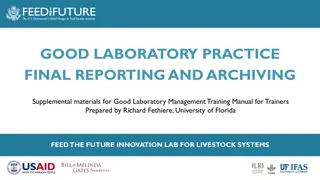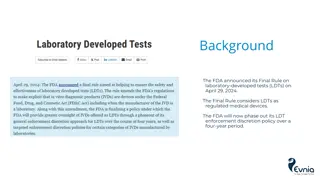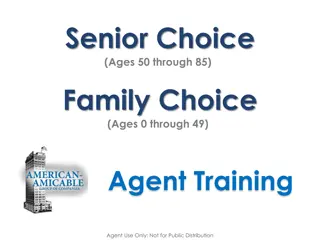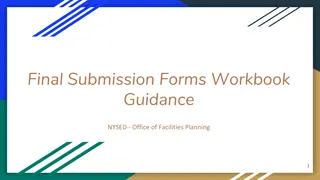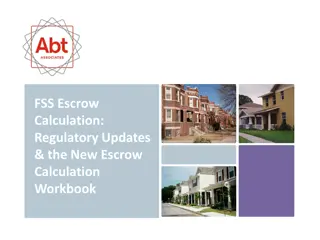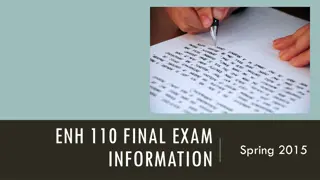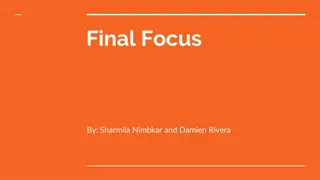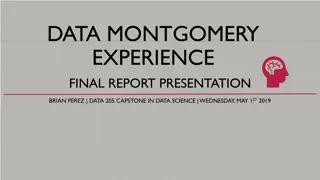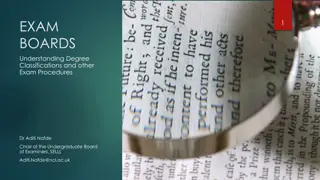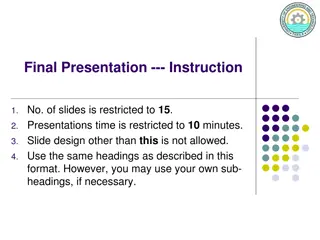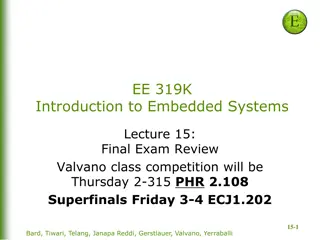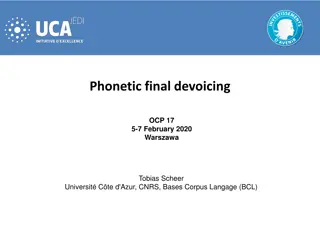Long-Term Effects of Ranibizumab Treatment on Diabetic Retinopathy Severity: DRCR.net Protocol I 5-Year Report
Phase 3 trials have demonstrated favorable changes in diabetic retinopathy severity in eyes treated with ranibizumab for diabetic macular edema. This study focuses on the 5-year outcomes of ranibizumab therapy in managing diabetic retinopathy progression, especially with decreasing exposure to anti-VEGF therapy over time. Detailed evaluations were conducted based on DR severity subgroups to assess rates of improvement and worsening. The findings emphasize the importance of long-term follow-up to determine the maintenance of treatment outcomes.
Download Presentation

Please find below an Image/Link to download the presentation.
The content on the website is provided AS IS for your information and personal use only. It may not be sold, licensed, or shared on other websites without obtaining consent from the author.If you encounter any issues during the download, it is possible that the publisher has removed the file from their server.
You are allowed to download the files provided on this website for personal or commercial use, subject to the condition that they are used lawfully. All files are the property of their respective owners.
The content on the website is provided AS IS for your information and personal use only. It may not be sold, licensed, or shared on other websites without obtaining consent from the author.
E N D
Presentation Transcript
Diabetic Retinopathy Clinical Research Network Changes in Diabetic Retinopathy Severity when Treating Diabetic Macula Edema with Ranibizumab: DRCR.net Protocol I 5-year Report 1
Background Phase 3 DME trials have shown eyes assigned to ranibizumab or aflibercept to manage DME have favorable changes in diabetic retinopathy severity relative to controls when followed for 2-3 years* More eyes improve Fewer eyes worsen Long term follow-up is needed to determine: If these outcomes are maintained Particularly when using a treatment regimen in which the exposure to anti-VEGF therapy decreases over time. * VISTA&VIVID, DRCR.net Protocol I 3-Year data, RISE&RIDE, Protocol T. 2
3-Year Retinopathy Worsening: Protocol I* Eyes with Baseline NPDR 50% A: Laser B: Ranibizumab + Laser C: Ranibizumab + Def D: Triamcinolone + Laser 37% 40% Cumulative Probability 30% 23% 18% 20% 10% 7% 0% 1 Year 2 Years 3 Years 3 *JAMA Ophthalmology 2013
3-Year Retinopathy Worsening: Protocol I* Eyes with Baseline PDR 50% A: Laser B: Ranibizumab + Laser C: Ranibizumab + Def D: Triamcinolone + Laser 40% Cumulative Probability 40% 30% 21% 20% 18% 12% 10% 0% 1 Year 2 Years 3 Years 4 *JAMA Ophthalmology 2013
Purpose To report DRCR.net Protocol I 5-year rates of retinopathy improvement or worsening: among eyes assigned to ranibizumab in the context of progressive reduction in exposure to ranibizumab therapy 5
Methods Rates of improvement and worsening were evaluated: In the ranibizumab treatment groups o Ranibizumab + deferred laser o Ranibizumab + prompt laser Within each DR severity subgroup*: o NPDR group (N=235) Level 10 through 53, i.e., very severe NPDR or less o PDR group (N=111) Level 60 or greater, i.e., PRP, inactive PDR through advanced PDR COMBINED INTO ONE GROUP 6 *Based on Reading Center grading of baseline fundus photos
Improvement of Diabetic Retinopathy between Baseline and each Annual Visit* 7 Limited to annual visits that required 7 field photographs
Criteria for Improvement Did NOT receive PRP Between baseline and annual follow-up Improvement on annual fundus photos* Did NOT receive vitrectomy or injections for PDR During follow-up on annual photos Improvement of Diabetic Retinopathy Did NOT develop NVI or NVA or NVG Did NOT develop vitreous hemorrhage Did NOT develop retinal detachment 8 *Based on Reading Center grading of annual fundus photos, excludes <20 (MA)
Criteria for Improvement Improved 2 or more levels on the ETDRS retinopathy scale* (applies to eyes with NPDR or PDR with potential to improve 2 or more levels) Did NOT receive PRP Between baseline and annual follow-up Improvement on annual fundus photos* Did NOT receive vitrectomy or injections for PDR During follow-up on annual photos Improvement of Diabetic Retinopathy to Inactive (if PRP at baseline) or No PDR (if no PRP at baseline)* Improved from active PDR Did NOT develop NVI or NVA or NVG Did NOT develop vitreous hemorrhage Did NOT develop retinal detachment 9 *Based on Reading Center grading of annual fundus photos, excludes <20 (MA)
Improvement of Diabetic Retinopathy With Ranibizumab Injections* Percentage of Eyes with NPDR PDR : P for trend=0.78 : P for trend=0.30 50% Improvement 38% 40% 35% 32% 29% 28% 28% 30% 25% 23% 20% 10% 0% Year 1 Year 3 Year 4 Year 5 191 40 170 34 148 28 137 26 N *among participants who were eligible to improve and had gradable fundus photograph at the specified annual visit 10
Improvement of Diabetic Retinopathy With Ranibizumab Injections* Percentage of Eyes with NPDR PDR : P for trend=0.78 : P for trend=0.30 50% Improvement 38% 40% 35% 32% 29% 28% 28% 30% 25% 23% 20% 10% 0% Year 1 Year 3 Year 4 Year 5 191 40 170 34 148 28 137 26 N 8 8 1 0 0 0 0 0 Median # of Injections IQR 6,10 7,10 0,4 0,4 0,3 0,2 0,3 0,2 *among participants who were eligible to improve and had gradable fundus photograph at the specified annual visit 11
Improvement of Diabetic Retinopathy With Ranibizumab Injections* Percentage of Eyes with NPDR PDR : P for trend=0.78 : P for trend=0.30 50% Improvement 38% 40% 35% 29% 28% 28% 30% 25% 23% 20% 10% 0% Year 1 Year 3 Year 4 Year 5 191 40 170 34 148 28 26 N 8 8 1 0 0 0 0 Median # of Injections IQR 6,10 7,10 0,4 0,4 0,3 0,2 0,2 *among participants who were eligible to improve and had gradable fundus photograph at the specified annual visit 12
Improvement of Diabetic Retinopathy With Ranibizumab Injections* Moderate NPDR or less vs Moderate-severe/Severe NPDR P=0.002 Percentage of Eyes with 50% 42% Improvement 38% 40% 35% 29% 28% 28% 30% 25% 23% 20% 15% 10% 0% Year 1 Year 3 Year 4 Year 5 191 40 170 34 148 28 52 85 26 N 8 8 1 0 0 0 1 0 0 Median # of Injections IQR 6,10 7,10 0,4 0,4 0,3 0,2 0,3 0,4 0,2 *among participants who were eligible to improve and had gradable fundus photograph at the specified annual visit 13
Relationship between injection number and improvement Number of injections between Baseline and the Specified Visit Improved 1-Year N=70 Median (IQR) 10 (7,11) P-value Not Improved N=161 7 (6,9) <0.001 3-Year Median (IQR) N=60 14 (8,19) N=144 11 (8,16) 0.02 4-Year Median (IQR) N=49 15 (10,23) N=127 13 (8,19) 0.02 5-Year Median (IQR) N=50 16 (11,30) N=113 15 (10,22) Eyes given more injections were more likely to improve at all annual visits 0.006 *among participants who were eligible to improve and had gradable fundus photograph at each annual visit 14
Improvement Status at 1 and 3 Years* Diabetic Retinopathy Status Relative to Baseline 47% of eyes with improvement at 1 year sustained improvement at Label N 25 1-Year Improved 3 years 3-Year Improved Improvement sustained Improvement not maintained Late improvement Improved Not improved 28 Not improved Improved 26 No improvement Not improved Not improved 107 *among participants who were eligible to improve and had gradable fundus photograph at each annual visit 15
Worsening of Diabetic Retinopathy through 5 Years* * subjects that did not complete 5-year visit AND did not meet worsening definition were censored at the last completed visit 16
Criteria for Worsening During follow-up on annual photos Developed retinal detachment Developed NVI or NVA or NVG Between baseline and follow-up Worsened 2 or more levels on the ETDRS retinopathy scale* Developed vitreous hemorrhage Received vitrectomy or injections for PDR Only applies to eyes without PDR at baseline Progressed from No PDR to PDR* Worsening of Diabetic Retinopathy Progressed from HRPDR to advanced PDR* Received PRP 17
Cumulative Probability of Retinopathy Worsening With Ranibizumab Injections* 40% PDR vs NPDR; P=0.01 Cumulative probabilities of 31% 30% NPDR PDR 23% worsening 19% 20% 18% 16% 15% 12% 8% 10% 5% 2% 0% 0 1 2 3 4 5 Time in Years # at risk 218 96 195 85 167 76 145 56 127 45 18 *Calculated using the lifetable method
Cumulative Probability of Retinopathy Worsening With Ranibizumab Injections* Rate of worsening did not change with time 40% P > 0.05 Cumulative probabilities of 31% 30% NPDR PDR 23% worsening 19% 20% 18% 16% 15% 12% 8% 10% 5% 2% 0% 0 1 2 3 4 5 Time in Years # at risk Median # of Injections 218 96 195 85 167 76 145 56 127 45 8 10 2 3 1 1 0 0 0 0 IQR 6,10 7,12 0,5 0,8 0,4 0,5 0,3 0,4 0,4 0,3 19 *Calculated using the lifetable method
Cumulative Probability of Retinopathy Worsening With Ranibizumab Injections* 40% Cumulative probabilities of 31% Moderate NPDR or better 30% Moderate-severe/Severe NPDR 24% 23% PDR worsening 19% 20% 16% 20% 18% 11% 8% 10% 8% 7% 5% 4% 1% 0% 0 1 2 3 4 5 Time in Years 87 131 96 82 114 85 77 91 76 62 83 56 # at risk 20 *Calculated using the lifetable method
Top 3 Events Triggering Worsening NPDR N=36 PDR N=29 Change on annual photographs one worsening criteria and 16 eyes developed NV at some point 36% 7% 10 eyes met more than Vitreous hemorrhage 33% 55% Panretinal photocoagulation 17% 21% 6 eyes met more than one worsening criteria at some point 21
Strengths and Limitations Strengths Prospective Long term follow-up Limitations Annual visits without gradable fundus photographs 14%/19%/31% at 1/3/5-yr visits* Limited number of eyes with baseline PDR Conditions other than PDR may have led to vitreous hemorrhage which may have overestimated the worsening rates in the PDR group 22 *among living participants
Conclusion Individuals managed with anti-VEGF therapy for DME may have simultaneous favorable alterations in the evolution of their retinopathy In this exploratory analysis, Improvement and Worsening rates did not appear to be altered by the marked reduction in exposure to ranibizumab during the later years of follow-up However, individual eyes may not maintain improvement, and worsening does occur, highlighting need for continued surveillance of DR level. 23
Thank You 24
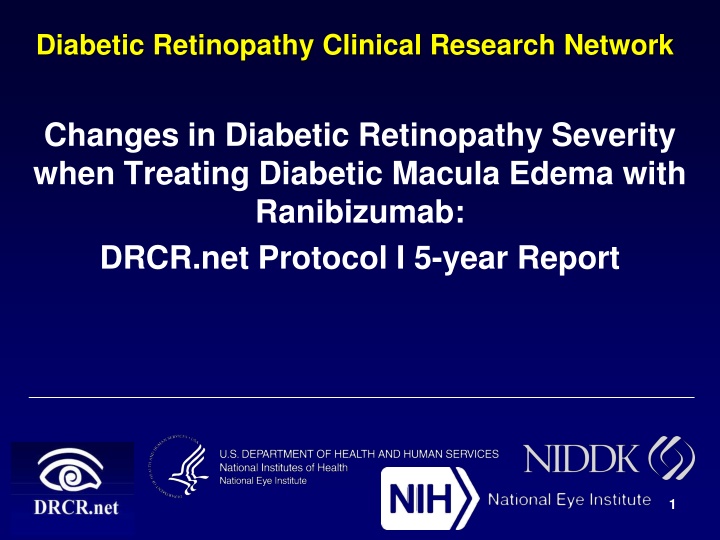

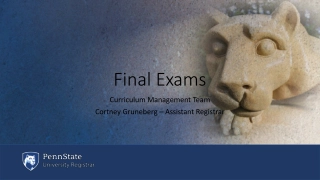
![READ⚡[PDF]✔ Yup I'm Dead...Now What? The Deluxe Edition: A Guide to My Life Info](/thumb/20463/read-pdf-yup-i-m-dead-now-what-the-deluxe-edition-a-guide-to-my-life-info.jpg)



